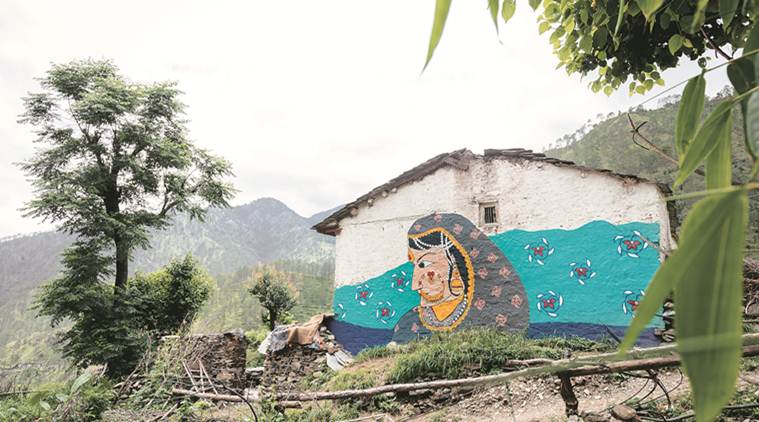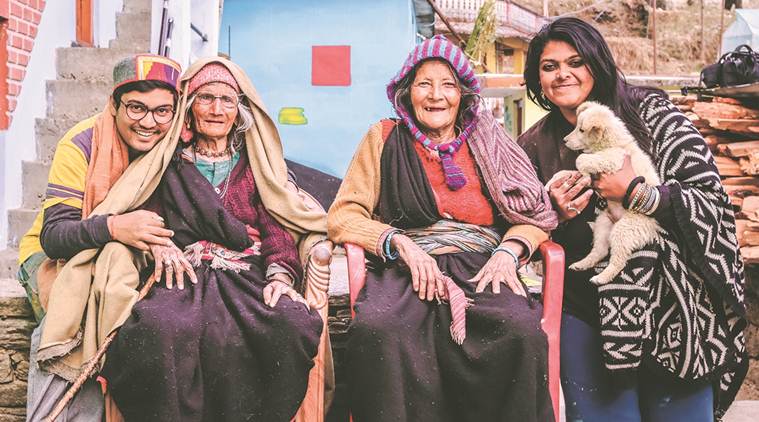Painting on the Wall
An art initiative turns a remote village, near Pindari Glacier in Uttarakhand, into an open-air gallery of murals

A mural in Saur shows a bride wearing the Garhwali nath
Khati, the last remote village on the Pindari Glacier trek route, has no electricity or roads and is home to 450 people. But the walls of the houses are bursting with colour. The figures, painted in Kumaoni style, are of children sitting under a tree with their books, a bride travelling in a palki, and trekkers with their backpacks. The art is the result of the Wise Wall Project that aims to capture scenes of age-old traditions of villages on the walls of the houses. The Wise Wall Project is a part of Project FUEL, an organisation that chronicles stories, and was founded by lyricist Deepak Ramola and artist Poornima Sukumar.
The Khati initiative involved 45 volunteer artists and around 150 walls. “I took inspiration from what was locally present. The goats and the flora and fauna are part of the artwork. The new thing for the villagers is the Kumaoni artform. It has disappeared so quickly that they themselves are learning from it,” says Sukumar.
One of the prominent images is of the flower festival called Phool Tyohar. The mural shows children visiting houses of the village and throwing flowers on the doorsteps so that the elders would come out and give them sweets. “It’s almost like Halloween,” says Sukumar. The project started last year, when the team visited a 600-year-old village, Saur, in the Garhwal region of Tehri in Uttarakhand. Surrounded by mountains, Saur is also known as a “ghost village” because of mass migration in recent decades. Only 12 families remain, but the houses are alive with local folklore and rural pastimes painted in a mix of Garhwal and Mughal miniature styles.
One hundred volunteers had come to the village in June 2017 and painted, among other scenes, a bride wearing a prominent Garhwali nath, an integral part of a local bride’s trousseau. On another wall, there is a group of musicians playing drums, reminiscent of the time villagers would gather in the courtyard and sing pleas to the Goddess Surkanda for fresh showers, and curse her the next day if the rains didn’t arrive.
It was a road trip in the Northeast in 2015 that Sukumar and Ramola began to to talk about how the unique elements of every community, from folk tales to philosophical sayings, are never documented. “We chose Uttarakhand because its has almost 1,100 abandoned villages. We also chose Khati because there are no roads, network, internet or electricity even in 2018,” says 26-year-old Ramola, a Dehradun-based songwriter who has written lyrics for Wazir and Manjhi – The Mountain Man. Bengaluru-based Sukumar, 30, points out how she used the Aipan, the traditional art from the region, for Khati’s cluster of houses.
The walls of Saur recall how once there was only one radio at the Pradhan’s house, where everyone would gather to listen to Akashvani Lucknow. The houses are also replete with images of the old folk game of Panch Patthar played by young girls using pebbles. Another wall reminds one of the time when men would gather at the house of Bol Chand, who owned a bronze hookah, and smoke and chat till morning.
What were the challenges for the artists? “One can get a BSNL network and we have to go up a mountain and hold the phone high above. It sounds like a movie. The region is at a high altitude and there is a lack of oxygen. It takes two days to get acclimatised to the cold climate,” says Sukumar, adding, “The mindset was also a factor. In Saur, we were painting houses of people and they would say, ‘hey, why don’t you paint the bathroom too?’ There were also a lot of superstitions. Villagers didn’t wanted us to paint people who are alive.”
One of the outcomes, the artists hope, is increasing tourism to the villages. “There is no reason for urban people to go to a ghost village in Garhwal. But, once you turn the whole village into an art gallery, tourism increases. With that comes additional sources of income and livelihood,” says Ramola.
One of the images is of a sewing machine. Ramola says it is an ode to 22-year-old Hema, who told her in-laws that she would work after marriage. Hema had noticed that villagers went 40 km every day to get fabric stitched. She opened her own tailoring shop, thus, becoming an important part of her community. He says, “Being an independent woman in such a rural village is an epitome of feminism and self-independence that we talk about for women across the world. And here on a glacier, a woman is able to do that on her own terms.
Her life lesson was to learn as much as she could.”
For all the latest Lifestyle News, download Indian Express App






















 Deepak Ramola (extreme left) and Poornima Sukumar (extreme right) with local residents of Khati
Deepak Ramola (extreme left) and Poornima Sukumar (extreme right) with local residents of Khati
No hay comentarios:
Publicar un comentario